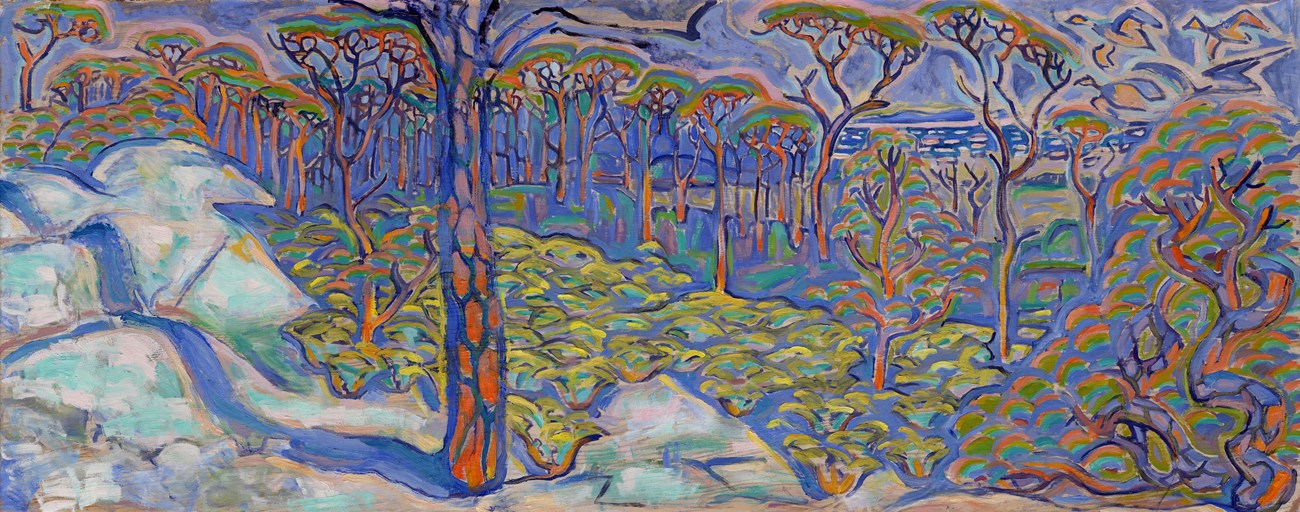|
“In order to realize the beauty of humanity we must realize our relation to nature.” -Walter Inglis Anderson 
Image used courtesy of the family of Walter Anderson. Before Horn Island became part of Gulf Islands National Seashore, it was a refuge for Walter Inglis Anderson. Known by the locals as “that crazy artist,” his family called him “Bob.” In the later years of his life, Bob rowed to Horn Island as often as possible. He created thousands of paintings and sketches inspired by the Mississippi island wilderness. Yet, Bob did not treat his works of art with care and most of his work was unseen during his life. Bob worked as a decorator at his family’s pottery shop. He married Agnes “Sissy” Grinstead in 1933. During this time, it became evident that Bob struggled with mental illness. Hospitalized against his will, Bob received a new form of shock treatment for mental health concerns. He escaped from several mental health hospitals. Once, he even disappeared for months and walked 1,000 miles from Maryland back to his home on the coast of Mississippi. Eventually, Bob found a balance living a life of recluse in coastal Mississippi. In 1944, Bob fell in love with the Mississippi islands, especially Horn Island. In the wilderness, he found an escape from the pressures and personal demons that plagued him on the mainland. His wife’s memoir paints a picture of two men. One that she loves, who opens her eyes to the natural world around them and lives at ease surrounded by wilderness. The other she fears, who irrationally insists his children are not his own and refuses to live in the same home as his family. In the last 20 years of his life, he rowed his small wooden skiff 12 miles to Horn Island 100 times or more. On these journeys his skiff capsized, he slept through hurricanes while nestled in the sand, and even stumbled upon the U.S. army testing biological warfare during World War II. Despite these challenges, he experienced Horn Island. Rising with the sun, Bob would marvel at the light and colors on the island. He would explore, take in all the sights, journal about his days, and find peace among the other wild things. It was painting that captured Bob’s heart and consumed his time. He painted with watercolors, quick to dry, so that he could capture fleeting moments before they were gone. Anderson wrote in his journal, “one image succeeds another with surprising regularity on Horn Island.” Inspiration was endless. He spent his days like this, sometimes for weeks at a time, while he lived on the island. Bob returned to the mainland, only when supplies ran out.
His paintings, much like the barrier island that inspired them, were not made to be permanent. Walter Anderson painted because he had to, with no concern about what happened to his completed works. It was not realized until he passed away how many pieces of art he had created. His wife, Sissy, found hundreds of drawings and watercolors littering Anderson’s cottage. Unfortunately, water damage and pests ruined much of his art. His remaining pieces gained him the respect and fame he never wanted or cared about during his life. Displayed today in the Walter Anderson Museum of Art and the William M. Colmer Visitor Center at Davis Bayou, his work serves as a reminder of nature’s ability to heal. As Bob wrote to his wife before journeying to Horn Island, he was “going home.” Just like Anderson, we all have a home in nature. Horn Island, preserved by Gulf Islands National Seashore and protected by the Wilderness Act, remains untrammeled and untouched by the hand of man. Today, its ready to welcome home any who have lost their connection to the natural world. Anderson, Agnes Grinstead. Approaching the Magic Hour- Memories of Walter Anderson. Edited by Patti Carr Black. Jackson, MS: University Press of Mississippi, 1989. Anderson, Walter I. The Horn Island Logs of Walter Anderson. Edited by Redding S. Sugg, Jr. Jackson, MS: University Press of Mississippi, 1985. David, Jack E. “An Untamed Island Meets Its Match.” The New York Times. New York, NY. June 27, 2017. https://www.nytimes.com/2017/06/27/travel/horn-island-mississippi-gulf-of-mexico-walter-anderson.html. Maurer, Christopher. Fortune’s Favorite Child: The Uneasy Life of Walter Anderson. Jackson, MS: University Press of Mississippi, 2003. Pickard, Mary Anderson. “Walter Inglis Anderson Biography (1903-1965).” Shearwater Pottery. http://www.shearwaterpottery.com/about/bio/walter/walter.html. “Realizations: The Walter Anderson Shop.” The Walter Anderson Shop. https://walterandersonart.com/. Upholt, Boyce. “The Many Voyages of Walter Anderson.” The Bitter Southerner. http://bittersoutherner.com/the-many-voyages-of-walter-anderson-horn-island-mississippi/. “A Voice in the Wilderness.” Gambit. New Orleans, LA. November 10, 2003. Walter Anderson Museum of Art. “Who We Are.” Walter Anderson Museum of Art. https://www.walterandersonmuseum.org/who-we-are. “Walter Anderson Papers.” The University of Southern Mississippi de Grummond Children’s Literature Collection. http://www.lib.usm.edu/legacy/degrum/public_html/html/research/findaids/DG0027f.html. |
Last updated: December 9, 2019
